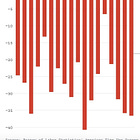The New Demands of Fitness
Why the invention of physical fitness marked a turning point in human adaptation—and why we must now extend that mindset far beyond the gym.
Hello Bar-setters,
Fitness is essential for anyone who wants to thrive in the modern world.
We typically associate fitness with physical health. But two prominent thinkers recently made a compelling case that to withstand the devolutionary effects of the smartphone, we need more than just physical fitness.
We must also cultivate social and cognitive fitness.
I’ll dedicate a short post to those later this week.
(Editors note: now that these have published, I have linked them at the bottom of this article)
But first, some context…
The Invention of Physical Fitness
For most of human history, people didn’t need to think about “working out.” Life itself was a fitness regimen—one that produced high VO2 maxes and lean, capable bodies by default.
Some warrior cultures—like the Spartans and Sioux—took physical training to superhuman levels. But for the average person, the idea physical fitness didn’t exist because it didn’t need to. See…
The Industrial Revolution change all that, however.
People left farms for sedentary, indoor jobs.
Calories became cheap and abundant.
And the standard diet gradually shifted from real food to what Michael Pollan calls “edible foodlike substances”—those industrially produced, hyper-palatable science experiments that dominate our grocery store shelves.
Consequently, waist lines expanded and physical health maladies proliferated.
So, many began to adapt. They began to talk about a concept called physical fitness and how us moderns needed to establish habits to develop it.
Suddenly, gyms, parks, and playgrounds began to pop up in each community. PE became a focal point of our educational agenda.
And we popularized practices like weightlifting, attending fitness classes, and jogging as standard approaches for combatting the ails of modernity.
New Technology = New Fitness Needs
In our world of hyper-palatable food, marketer manipulation, and overwhelming comfort, we must help our children learn to value their health. If we do not teach them to be healthy, they’ll likely succumb to this:

Just as the Industrial Revolution created this need for physical fitness, the digital revolution has created the need for other kinds of fitness.
The smartphone—and its constellation of digital distractions—has reengineered our lives in ways that leave us mentally scattered and socially stunted.
To meet the moment, we must now develop two new forms of fitness:
Social fitness. Cognitive fitness.
These were once built into daily life. Today, we have to train for them.
In my next post, I’ll break down each of these forms of fitness—how we suffer in their absence, and how we (and our children) can establish protocols to thrive.
Thank you for reading and sharing with anyone who would find this interesting! Here are the two follow up posts in this series:
If you enjoyed this, check out this related post:
Shane











I go to the gym to do easily repeated, infinitely scalable, hunting-like activities.